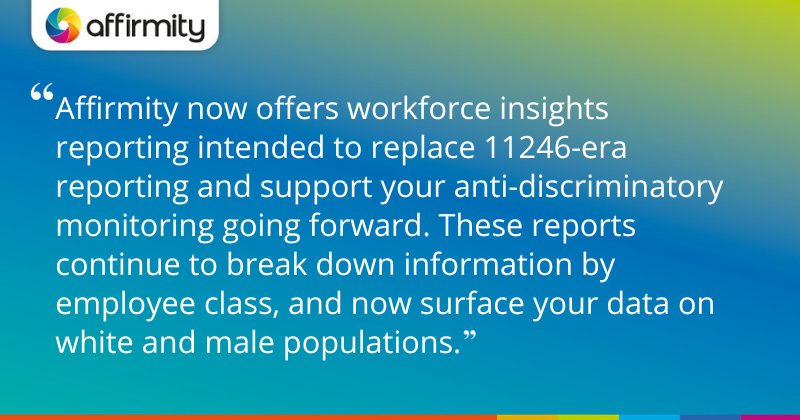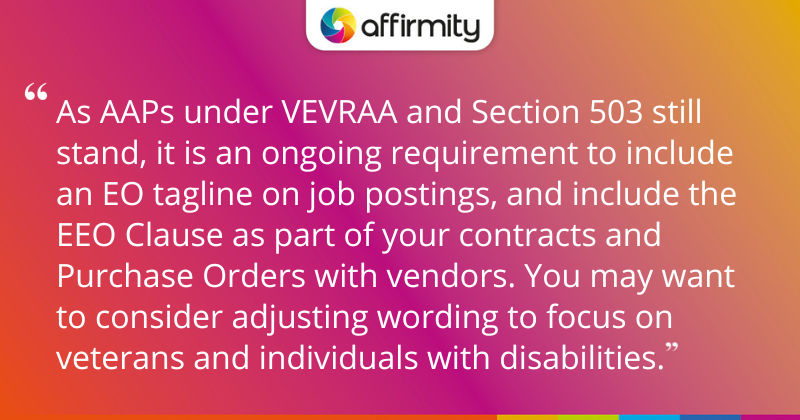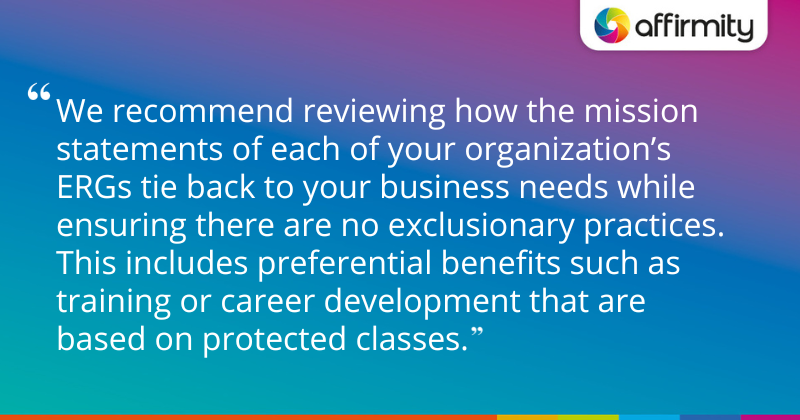We’re now a couple of months into the post-EO 11246 era initiated by President Trump’s Executive Order 14173, “Ending Illegal Discrimination and Restoring Merit-Based Opportunity.” Our consultants have received a large number of questions from organizations grappling with the implications of 14173 and a succession of other EOs targeting “illegal DEI”. In this article, we’re sharing our answers to these FAQs to help a wider audience with the new requirements for workforce analytics and compliance.
Q: What Data Should We Continue to Collect and How Should We Use It?
Maintaining and analyzing workforce data remains the best way to defend against discrimination claims, so your data should continue to facilitate an inclusive approach and prevent any inadvertent bias. We recommend that you continue to collect:
- Demographic data: race, ethnicity, and sex data for all job applicants and employees. This data will continue to be relevant to adverse impact testing and some states and local jurisdictions still mandate collection of this same data.
- Veteran and disability self-identification data. Note that the federal requirement to resurvey employees every five years still remains in effect.
Ensure that your data collection practices continue to follow the Uniform Guidelines on Employee Selection Procedures (UGESP). We also recommend continuing to maintain records, both applicant and employment-related. In essence, we believe that organizations should only change their recordkeeping practices if they believe they are falling short of the myriad of different requirements that still exist. If you’re considering changing your practices, make sure you validate your plans with internal or external counsel.
READ OUR INITIAL BEST PRACTICE ADVICE | ‘A Best Practice Approach to Ensuring Non-Discrimination in the Post-EO 11246 Era’

Q: Do You Advise Contractors to Still File Affirmative Action Plans and Certify With the OFCCP Under Safe Harbor?
Federal contractors are not currently required to file AAPs but they must still prepare, implement, and maintain an annual AAP for veterans and individuals with disabilities. The OFCCP is not currently conducting compliance evaluations but the Wall Street Journal reports that the agency will be looking at legacy plan submissions for evidence of discriminatory work policies. Otherwise, we await further information as to how the current EOs will be enforced. OFCCP compliance certification is also currently on hold.
Q: Can We Still Use the Reports We Used for Affirmative Action Plans? Or Do We Want to Separate Our Language and Reports From Affirmative Action?
Under EO 14173, all reports and language pertaining to EO 11246-related women and minorities affirmative action plans have been rescinded. Federal contractors are no longer required to prepare these reports or narratives. Affirmative action plans for VEVRAA and Section 503 still exist, along with all previously required reporting and narrative language. As it stands today nothing has changed for these protected veterans and individuals with disabilities affirmative action programs.
Affirmity now offers workforce insights reporting intended to replace 11246-era reporting and support your anti-discriminatory monitoring going forward. These reports continue to break down information by employee class, and now surface your data on white and male populations. Your Affirmity consultant will be happy to walk you through some sample reports, or if you’re not yet an Affirmity client, please get in touch.
Q: What Will Happen to Affirmity’s Affirmative Action Plan Software?
All of our affirmative action plan software will remain available for the foreseeable future to enable continued client use and access to historical plans. Affirmity is also developing new software solutions that support upcoming state and federal regulations. Additionally, we’re exploring solutions that provide a framework for supporting lawful ways to increase diversity and remove barriers to equal employment opportunity in the workplace.
IMPORTANT INFORMATION ABOUT LEGACY PLANS | ‘Recent OFCCP Developments Under Its New Director, the Compliance Implications, and Your Next Steps’
Q: Could We See States Require AAPs in the Future, Or Does the Recission of 11246 Make It Illegal for States to Do So?
EO 14173 applies only to federal contractors (all recipients of federal funding). States are still allowed to create their own requirements as part of conducting business in that state, and it’s possible that certain states may ramp up their affirmative action and other compliance requirements to fill gaps they believe have been created at the federal level.

Q: Should We Still Follow the Internet Applicant Rule to Assess for Adverse Impact Under the UGESP? Or Was That Revoked As Well?
The Internet Applicant Rule was part of EO 11246 and is therefore no longer a requirement. However, you still need to conduct adverse impact testing, and understanding who is considered an applicant and collecting the necessary disposition details is still an important step in ensuring you are including the correct applicant pool as part of your analysis.
According to the FAQ of the Uniform Guidelines on Employee Selection Procedures:
“The precise definition of the term “applicant” depends upon the user’s recruitment and selection procedures. The concept of an applicant is that of a person who has indicated an interest in being considered for hiring, promotion, or other employment opportunities. This interest might be expressed by completing an application form, or might be expressed orally, depending upon the employer’s practice.
The term “candidate” has been included to cover those situations where the initial step by the user involves consideration of current employees for promotion, or training, or other employment opportunities, without inviting applications. The procedure by which persons are identified as candidates is itself a selection procedure under the Guidelines.
A person who voluntarily withdraws formally or informally at any stage of the selection process is no longer an applicant or candidate for purposes of computing adverse impact.”
LEARN MORE ABOUT THIS ISSUE | ‘How to Address Adverse Impact in the Hiring Process’
Q: What Verbiage Should We Be Using in Our Job Posting Templates?
As AAPs under VEVRAA and Section 503 still stand, it is an ongoing requirement to include an EO tagline on job postings, and include the EEO Clause as part of your contracts and Purchase Orders with vendors. You may want to consider adjusting wording to focus on veterans and individuals with disabilities. No new revised language has been proposed, but in the meantime, we recommend using “equal opportunity employer”, and including references to individuals with disabilities and veterans in your taglines.
Q: What Sex/Gender Options Should We Include In Our Data Collection?
It’s always best to consult with your counsel as certain states may require the collection of other demographic data. Federal gender options are “Male”, “Female,” and “Do not wish to provide”. You do have the option to collect beyond these options, i.e. including non-binary/Gender X. Before doing so, be sure to understand how that data is going to be collected and used.

Q: Should We Continue to Save Applicant Logs If We Conduct a Search On an External Job Board?
As posting with state external job boards is required as part of VEVRAA and Section 503 Affirmative Action Programs, you are still required to maintain records as proof that you are meeting this requirement.
Logs for more generalized searches outside of your VEVRAA and Section 503 obligations on external job boards fell under EO 11246, and are consequently no longer required.
Q: Does Operating ERGs Expose a Company to Legal Risk?
Employee Resource Groups (ERGs), when implemented and executed properly, are a fantastic way to develop a sense of belonging within an organization. They’re not considered intrinsically “illegal” or discriminatory.
However, it should be considered best practice to review group membership requirements, policies, and activities to ensure they’re not providing preferential treatment of one group over another, or unintentionally creating an exclusive vs. an inclusive environment. For example, ERGs should not limit membership exclusively to those the group is centered around. So, a Women’s ERG should not only accept applications from women.
Until the current administration provides more information regarding what “illegal DEI programs” are, companies should focus on reviewing their current DEI programs—including ERGs—for any areas of concern or potential future risk. We recommend reviewing how the mission statements of each of your organization’s ERGs tie back to your business needs while ensuring there are no exclusionary practices. This includes preferential benefits such as training or career development that are based on protected classes.
ERG INSIGHTS FROM OUR ARCHIVES | ‘3 Key Ways Employee Resource Groups Are Improving Global Organizations’
Q: We Provide Bonus Payments to the Leaders of Our ERGs. Is There an Issue With Continuing This Practice Under the New EOs?
EO 14173 prohibits “illegal preferences and discrimination” and may eventually require federal contractors to certify that they do not participate in or encourage “illegal DEI programs”. As it stands today, we have been provided only limited guidance as to what “illegal DEI programs” may involve—the EEOC has a page on the subject here. We strongly recommend using this time to review your programs and consulting with legal counsel as to any potential programs that support preferential treatment of one group over another.
This is not to say that your bonus payment specifically is considered at risk. Nonetheless, it would be a good idea to consult with your internal/external counsel for further guidance with regard to any programs you have that may be deemed as favoring one group over another.
To equip your organization with software and solutions that address incoming policies and evolving non-discrimination best practices, contact us today or reach out to your dedicated consultant or account manager.
 About the Author
About the Author
Aly Ferguson is a Senior Business Consultant for Affirmity and has been with the organization for over ten years. She consults with clients in a variety of industries concerning workforce compliance and non-discrimination best practices along with inclusion planning, implementation, and measurement.
